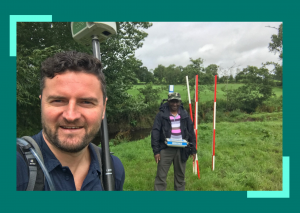Finding Dykes
Thursday, 08 October 2020
The groundwater team has been busy trying to find dykes, which are walls of molten rock that squeeze up through cracks in the earth’s crust. A dyke’s size can vary from only a metre or so up to 10’s of metres wide. In 2005, the Tellus project found that
- Published in news
No Comments
Riparian Works to Improve Water Quality
Thursday, 08 October 2020
As instream/riparian works are beginning to take place in all three catchments, it may be useful to highlight some of the measures being implemented. A challenge with river restoration and water quality improvement projects can often be that different areas require differing solutions and there is no ‘one size fits
- Published in news
Chemical Export to Watercourses in the Finn Catchment
Thursday, 08 October 2020
As part of the chemical export investigations the Loughs Agency team has carried out surveys on Sheep Dip and Forestry practices within the Finn catchment. These practices are potentially significant sources of herbicides and pesticides reaching local watercourses. Loughs Agency plan to use the information gathered in the surveys
- Published in news
Phase Two funding open to assist Local Communities improve Local Rivers
Wednesday, 19 August 2020
The second phase of the CatchmentCARE Community Incentive Scheme (CIS) has been launched to support cross border river catchment improvement projects in the rivers Arney, Blackwater and Finn. Project funding of up to €25,000 is available through the CIS to support communities who are interested in looking after their
- Published in news
New CatchmentCARE Paper highlights the Benefits of Diversifying to Woody Biomass Crops
Tuesday, 28 July 2020
A new CatchmentCARE paper sets out to illustrate the environmental and economic benefits of agricultural diversification to biomass crops and poses the question as to whether we should be implementing a strategic plan to facilitate the planting of this versatile crop. The paper uses a case study from a waste water treatment works in Bridgend,
- Published in news
CatchmentCARE Map Gallery launched
Tuesday, 28 July 2020
The CatchmentCARE website contains a new feature – The CatchmentCARE Map Gallery. The Map Gallery presents a collection of maps, story maps and apps for the CatchmentCARE Project and allows users to access lake, groundwater and river water quality data for the cross border catchments of the Arney, Blackwater and Finn. The Gallery also contains
- Published in news
Local Communities benefit from CatchmentCARE Training Programmes
Tuesday, 28 July 2020
A variety of exciting community based training programmes is being rolled out for local groups across the three catchment areas. Local community groups indicated they would benefit from training in standardised water assessment and survey techniques, to produce baseline evidence and to target action plans for the improvements of rivers and water bodies in their
- Published in news
River Works Begin in Blackwater Catchment
Tuesday, 28 July 2020
Blackwater Catchment Officer Tom Woods has been developing and delivering Riparian and In-Stream works around the Ballygawley area of the Catchment, which suffers badly from silt deposition / runoff and excessive nutrient loading. Tom has been working with local landowners and farmers to draw up agreements for accessing river sites on private land, as well
- Published in news
Conference highlights Willow Plantations’ Contribution to a more Sustainable Environment
Tuesday, 28 July 2020
With river catchments throughout Ireland suffering from increasing levels of pollution, a recent cross border seminar explored the benefits of using nature-based solutions for Water Quality Protection. The event in Dundalk explored the benefits of Short Rotation Coppice (SRC) Willow Planting and aimed to assess stakeholder interest & commitment to the principle of SRC and
- Published in news
Looking Underground without Digging a Hole
Tuesday, 28 July 2020
The CatchmentCARE team has been helping with the ‘Source to Tap’ project in the Derg Catchment in Donegal and Tyrone to get a better understanding of how the herbicide MCPA is getting into local rivers. Two groundwater-monitoring stations are to be installed in the region, but the type of geology there makes it difficult to
- Published in news










